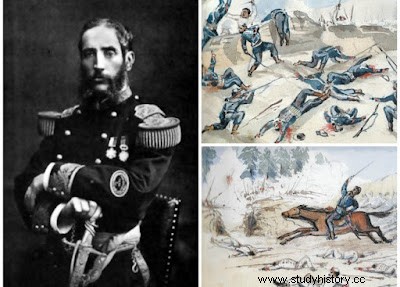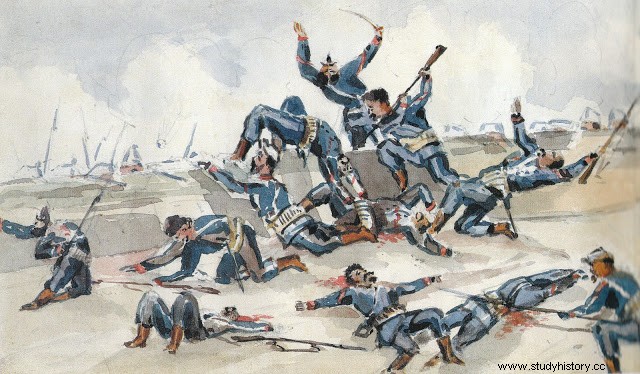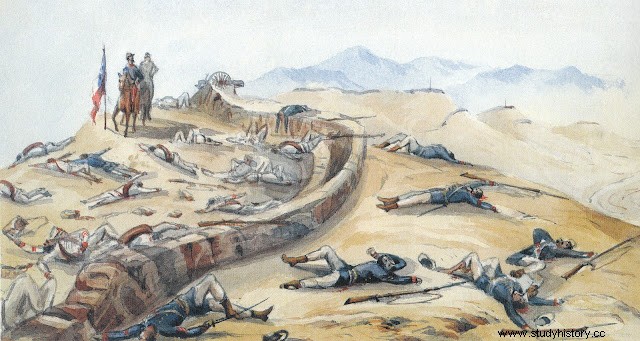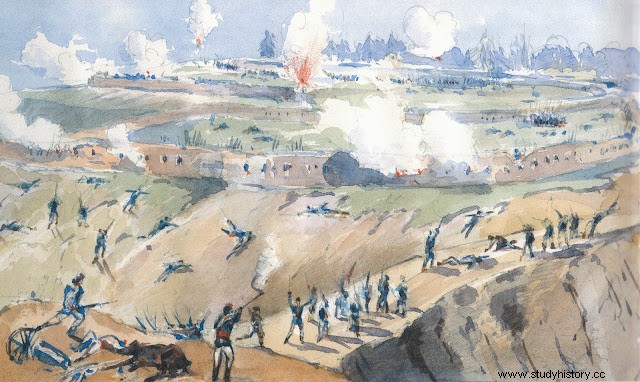It was half past four in the morning and the field was covered with mist, which favored the approximate advance of the Chileans. And shortly before the crack of dawn they showed up unexpectedly, without having fired, on the almost defenseless part that was left between Iglesias's left and my right. When I heard that a violent firefight began, I understood that the enemy had penetrated through that unguarded place in our line, and I immediately went there, where El Dictador also headed, in this way the then Colonel Andrés Avelino Cáceres began his story of The Battle of San Juan took place on a day like today, January 13, but in 1881 during the War of the Pacific.

That day about 30,000 soldiers from the Chilean regular army faced 15,000 Peruvian men poorly organized and covering a 14-kilometer line of fire as part of Lima's first line of defense against the southern invasion. According to Mariano Felipe Paz Soldán, the Peruvian forces were arranged in four corps:the first commanded by Miguel Iglesias, on the right with 5, 200 men; the fourth in the center with 4,500 under the orders of Andrés A. Cáceres; the third, on the left, with 4,300 soldiers led by Justo Pastor Dávila; the second body of 2,500 men constituted the reserve and was under the orders of Belisario Suárez. At that time Nicolás de Piérola ruled Peru under the character of Dictator. 'El Califa' had occupied the presidency on December 21, 1879 after removing Vice President Luis La Puerta (in charge of the Presidency when Manuel Prado traveled to Europe to expedite the purchase of weapons for the War with Chile) from power. , I was able to confirm my presumptions and called Mr. Piérola's attention telling him:“You see, the enemy is on our line”. We immediately advanced to the foot of a hill, at the top of which was one of the battalions of the Ayarza division, when I saw that the Chileans had actually penetrated that unguarded clearing and were attacking us from behind. So I said to the Dictator:"The Chileans are behind our line and attack us from behind." The Dictator looked astonished and without saying a word, turned his horse and left for Chorrillos..."While Ayarza's troops fought hard, I sent one of my assistants to ask Colonel Suarez, who commanded the reserve and was in the rear, to come to our support and try to contain the enemy who was advancing without major obstacles through the unguarded hole, Suárez sent me to say, in response, that he could not attend my call because he had received the dictator's order to withdraw to Chorrillos. Meanwhile, the fight on the right wing continued and the fire spread throughout the line. It was no longer possible to subtract any of the battalions that were taking part in the fray to oppose the advance of the enemy.

Leaving Ayarza to hold the right, I headed towards the center of the line, defended by the Pereira division and with which the artillery was. I arranged for it to intensify fire on the enemy troops advancing along the front, and I ordered Pereira to hold there, making his soldiers lie on the ground behind the mounds of sand formed on the hill, in order to take better aim. on the container, presenting him at the same time less target. I immediately went to the left, defended by Colonel Lorenzo Iglesias, and upon arrival I found that his troops had been completely killed, for not having occupied the positions that I indicated contrary to my orders . The enemy had exceeded the extreme left of the sector, formed by the Ayacucho battalion. (…) Heading to the right again, I was informed that the Ayarza division had been defeated, after a hard and intense struggle, and its brave leader had heroically died. Thus, in less than three hours-from dawn to about nine o'clock-our line had been completely destroyed by the enemy. I found myself without soldiers and only accompanied by my assistants on a small hill, where my presence was no longer necessary. object, and furthermore, almost surrounded by enemy troops who, at that time, were occupying the San Juan hacienda, pouring in from one side and the other, after having also dispersed Dávila, who constituted the left wing of our extensive and weak line of defense. .(…)Meanwhile, Dr. Lorente insistently requested reinforcements by telegraph for Colonel Iglesias, whom he assumed was fighting at that time, judging by the crackle of rifle fire. General Silva sent for me and suggested that I go to the aid of Iglesias who, according to Dr. Lorente's repeated requests, was still resisting in Morro. I took 400 men from those already gathered in the camp and left immediately.

Passing through Barranco, I found Colonel Suárez with the army corps he commanded. Seeing that Suárez was withdrawing so calmly, I couldn't contain myself and told him:“I don't understand the reason for his withdrawal, finding Iglesias fighting, and, above all, when he asks for reinforcements”. Colonel Suárez told me that Iglesias had been taken prisoner at ten o'clock that day and that the troops that remained on the top of El Morro had already withdrawn and dispersed. "The troops that you see there - he added - are from the Chileans and the shooting that you hear is from them, who have given themselves over to looting, breaking down the doors of shops and houses." - "Well, well," I replied. -I am going to comply with the order of the chief of staff”. And I continued my march towards Chorrillos; Suárez followed his to Miraflores. His army corps was complete, with the exception of a battalion that Recavarren voluntarily led to the aid of Iglesias and that was destroyed in Chorrrillos. with my telescope that Chilean troops were indeed occupying the Morro and heights adjoining the town of Chorrillos. It was one in the afternoon. Nevertheless, and taking due precautions, I entered Chorrillos. In the first of the streets I bumped into a group of enemy soldiers, whom I attacked and put to flight; but moments later I was attacked by superior forces who tried to cut me off, which prevented the opportune intervention of the frigate captain Leandro Mariátegui, who arrived in that circumstance driving a cannon mounted on the platform of a car and fired at them. In this way I was able to contain the enemy push and continue fighting; but the adversary was getting stronger with the adduction of our troops; and then realizing how useless it would be to prolong the fight without the hope of receiving any effort and with soldiers who were already beginning to falter, due to the casualties suffered, I decided to interrupt the combat and return to Miraflores, convinced of the failure of our efforts and deeply saddened. of the misfortunes of Peru...

THE DATA It should be noted that Colonel Miguel Iglesias sustained a prolonged fight against the Chileans in Morro Solar throughout the day until 4:30 in the afternoon when he was taken prisoner. The images in this note are watercolors by Rudolph de Lisle, an English soldier who was in Peru during the Defense of Lima and observed the outcome of the battles.
Source:Memories of the War of 1979 by Andrés A. Cáceres and Historical narration of the Chilean War against Peru and Bolivia by Mariano Felipe Paz Soldán.
